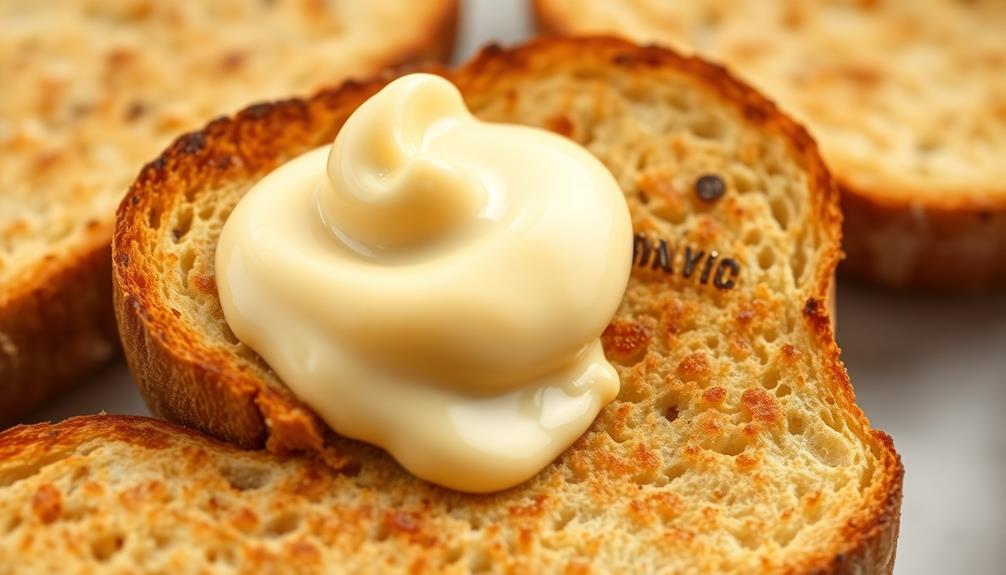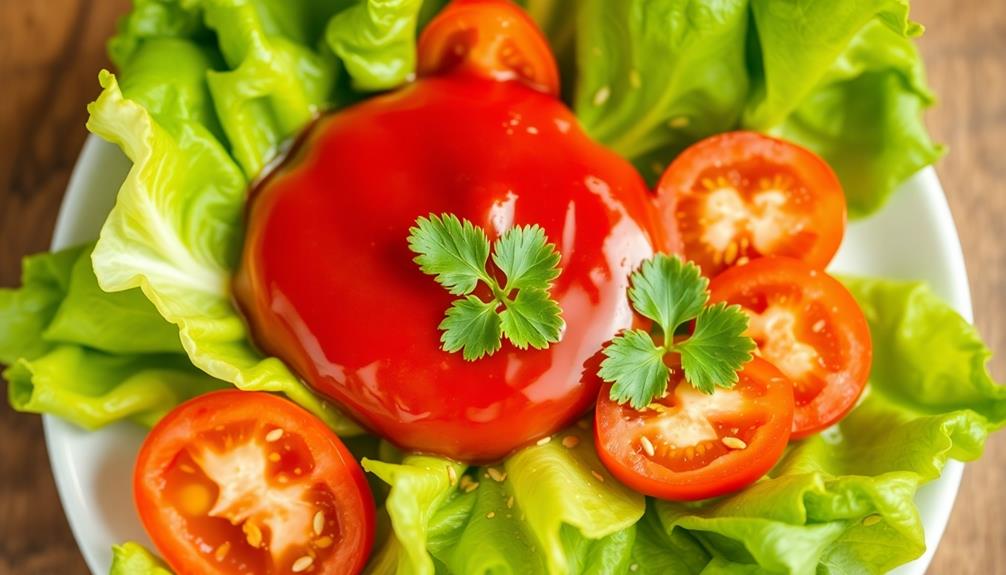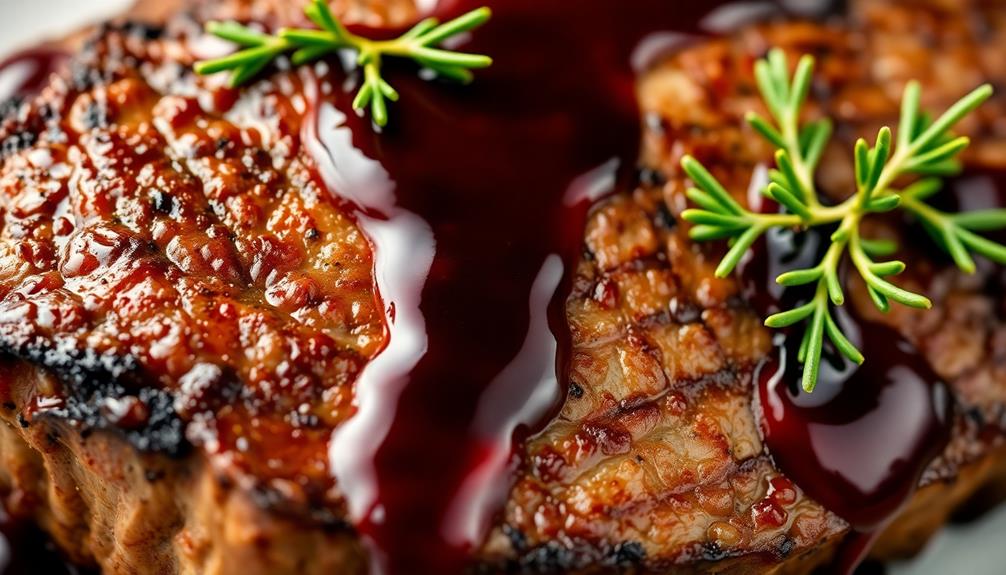Crafting the perfect mayonnaise is an incredibly satisfying culinary experience. You'll discover its origins trace back to 18th century France, where a clever chef created this thick, creamy emulsion for a duke. Today, mayonnaise is a beloved condiment elevating sandwiches and salads worldwide. The key is slowly incorporating oil into egg yolks while whisking continuously to achieve that luscious texture. Homemade offers unbeatable flavor compared to store-bought. With a few simple ingredients and some practice, you'll master this technique. Once you've conquered mayonnaise, you'll be excited to explore all the flavorful ways to customize it.
Key Takeaways
- Mayonnaise is an emulsion with a rich history, originating in 18th-century France, and has become a beloved condiment globally.
- Homemade mayonnaise offers superior flavor compared to store-bought options, with a focus on proper emulsification and seasoning.
- Mastering the techniques of slow oil incorporation, consistent whisking, and gentle mixing is crucial for creating a creamy, stable mayonnaise.
- Storing mayonnaise properly in an airtight container and using it within a week ensures optimal freshness and texture.
- Mayonnaise can be customized with various herbs, spices, and citrus to create unique flavor profiles, perfect for sandwiches and dipping.
History
Mayonnaise's origins can be traced back to the 18th century, when a French chef created the creamy condiment during a celebratory meal for the Duke of Richelieu. The chef whipped together egg yolks, oil, and a few secret spices, forming a thick, velvety texture that delighted the duke's palate.
From that moment on, mayonnaise became a staple in French cuisine, spreading across Europe and eventually the world.
As the years passed, different cultures put their own spin on the classic recipe, adding unique flavors and twists. Spaniards, for instance, blended in garlic to create aioli, while Americans experimented with tangy mustard and zesty lemon.
Today, mayonnaise is enjoyed in countless ways, from the classic sandwich spread to the creamy base of potato salad. Its versatility and rich flavor have made it a beloved condiment, cementing its place in culinary history.
Recipe
Homemade mayonnaise is a versatile condiment that can elevate any dish. It's surprisingly easy to make, and the taste is incomparable to store-bought varieties. With just a few simple ingredients and a little bit of elbow grease, you can whip up a batch of creamy, tangy mayonnaise that will have your taste buds dancing.
The key to perfect mayonnaise is emulsion. By slowly incorporating the oil into the egg yolk, you create a thick and creamy texture that coats your tongue with deliciousness. It's a bit of a dance, but once you get the hang of it, you'll be a mayonnaise-making pro in no time.
- 2 large egg yolks
- 1 tablespoon Dijon mustard
- 1 tablespoon lemon juice or white wine vinegar
- 1 cup neutral-flavored oil (such as vegetable, canola, or grapeseed)
- 1/2 teaspoon salt
In a medium bowl, whisk together the egg yolks, Dijon mustard, and lemon juice or vinegar until well combined. Slowly, while continuously whisking, drizzle in the oil a few drops at a time, allowing the mixture to emulsify before adding more.
Once the mixture starts to thicken, you can gradually increase the flow of oil. Continue whisking until all the oil is incorporated and the mayonnaise is thick and creamy. Season with salt to taste.
Cooking Steps
Slowly drizzle the oil into the yolks, whisking constantly until the mixture thickens.
Once it's nice and creamy, stir in your favorite seasonings and adjust the consistency to your liking.
Step 1. Slowly Drizzle Oil Into Yolks

Starting with a well-beaten yolk, you'll gently drizzle in a steady stream of oil, whisking constantly to emulsify the mixture.
This slow, patient process is the key to creating a smooth, creamy mayonnaise that can enhance your favorite dishes and appetizers, such as Crab Cakes.
Don't rush it – take your time and let the oil gradually incorporate into the yolk. As you whisk, you'll notice the mixture thickening and becoming emulsified, transforming into a rich, glossy mayonnaise.
Be sure to add the oil in a thin, steady stream, whisking vigorously to prevent the emulsion from breaking.
With practice, you'll develop a feel for the perfect oil-to-yolk ratio and the right speed for incorporating the oil.
Mastering this technique is the secret to making mayonnaise that's far superior to anything store-bought.
The homemade version will have a luxurious, velvety texture that elevates any dish.
Step 2. Whisk Yolks Until Thickened
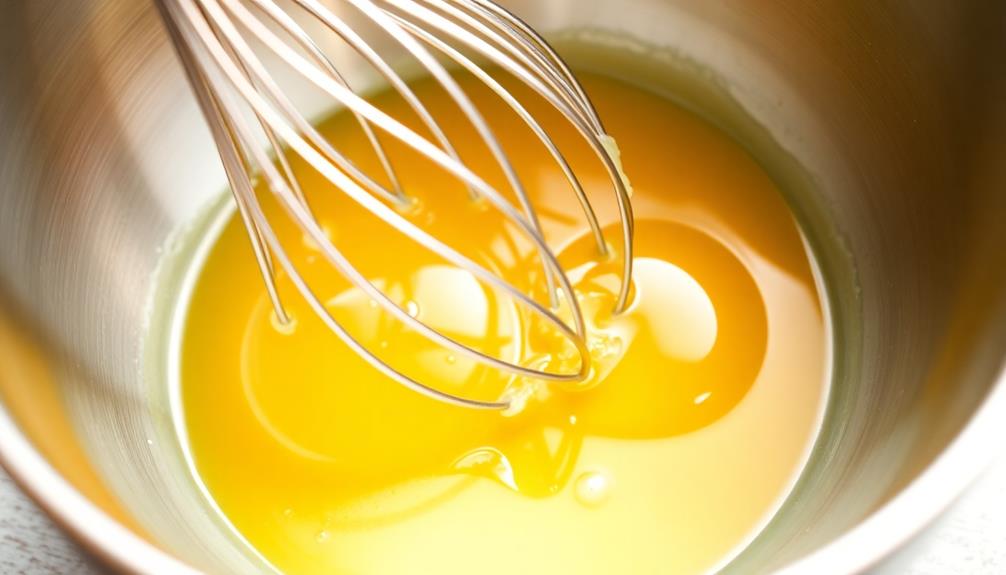
Once you've meticulously drizzled in the oil, it's time to whisk the yolks until they've thickened. This crucial step helps create the creamy, emulsified texture that makes mayonnaise so delightful.
Using a whisk, begin stirring the yolks vigorously. You'll notice the mixture start to transform, becoming thicker and richer as you work. Don't be afraid to put some muscle into it – the more you whisk, the better the mayonnaise will come together.
Keep a steady, consistent rhythm, making sure to scrape down the sides of your bowl occasionally. As the yolks thicken, you'll see them start to lighten in color and take on a silky, glossy appearance. This is exactly what you're looking for!
Once the mixture has reached the desired consistency, you're ready to move on to the next step. With the hardest part behind you, you're well on your way to mayonnaise perfection.
Step 3. Add Seasonings and Adjust Consistency
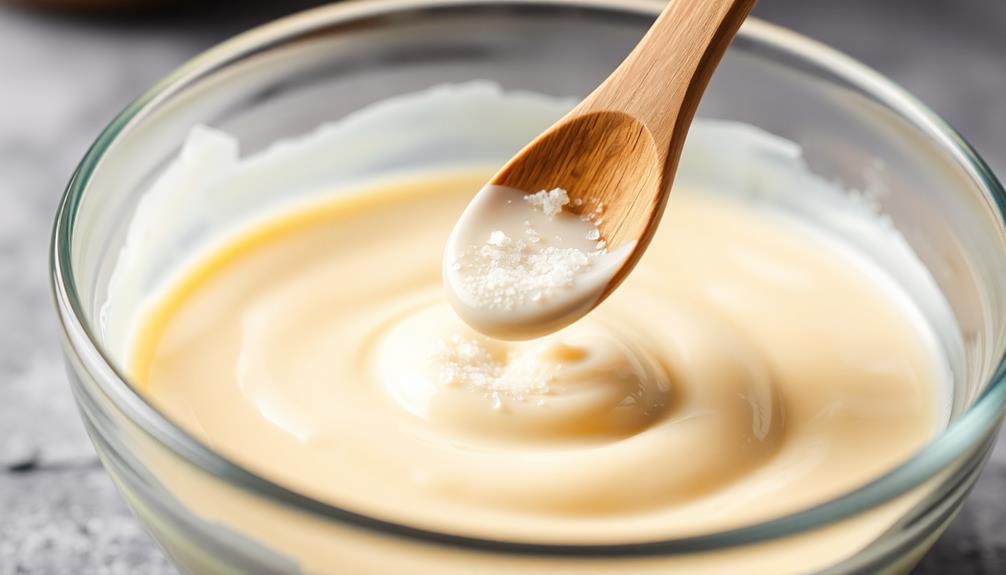
Next, you'll want to add any desired seasonings to your thickened yolk mixture. A pinch of salt and a dash of white pepper work wonderfully to enhance the flavor, and you might also consider incorporating a touch of herb-infused butter for an extra layer of richness.
Stir these in gently until fully incorporated. Now, it's time to adjust the consistency of your mayonnaise to your liking.
If the mixture seems too thick, you can thin it out by slowly adding in a few drops of the reserved lemon juice or water. Whisk continuously as you do this, ensuring the emulsion remains stable.
Conversely, if the consistency is too thin, you can thicken it by slowly drizzling in a bit more oil while whisking vigorously. This technique is similar to creating a buttery texture in baked goods, which enhances the overall mouthfeel.
The goal is to achieve a silky, creamy texture that holds its shape nicely. Once you've reached the perfect consistency, give your mayonnaise a final taste and adjust the seasoning if needed.
Now you're ready to use your homemade masterpiece in your favorite recipes!
Step 4. Fold in Any Remaining Oil
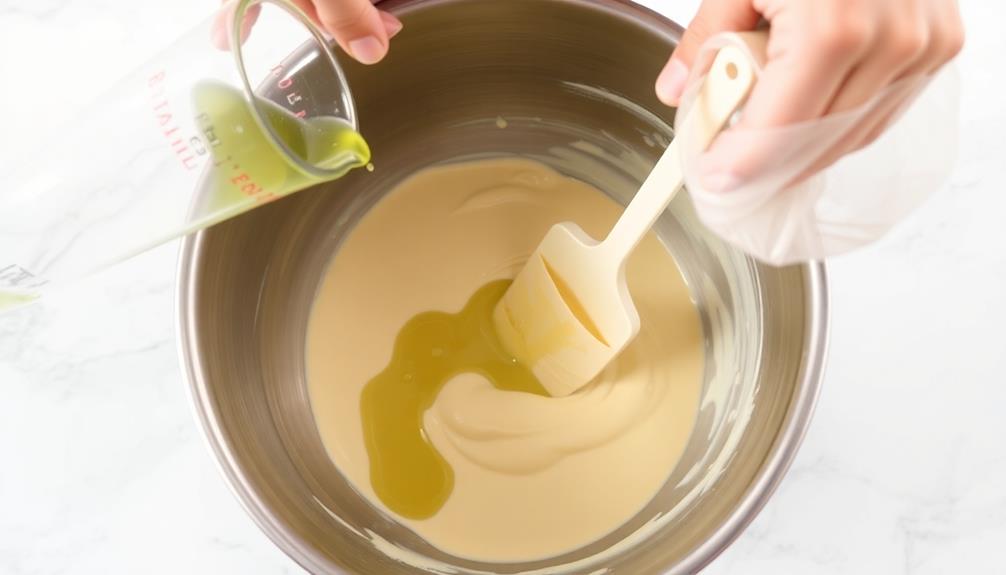
With your mayonnaise now at the desired consistency, fold in any remaining oil.
Gently incorporate the oil using a rubber spatula, folding and turning the mixture to fully combine it. This step helps to create a smooth, creamy texture and ensures all the oil is emulsified into the egg yolk base.
Don't worry if there's a bit of oil left – just keep folding until it's fully incorporated. The key is to be gentle and patient, taking your time to fold the mixture rather than stirring vigorously, which can break the emulsion.
Once the oil is fully folded in, your mayonnaise is ready to use! Whether you're dressing a salad, topping a sandwich, or using it as a dip, this homemade mayonnaise will elevate your dish with its rich, velvety texture and bold, tangy flavor.
Enjoy the satisfaction of creating this culinary staple from scratch.
Step 5. Store in Refrigerator
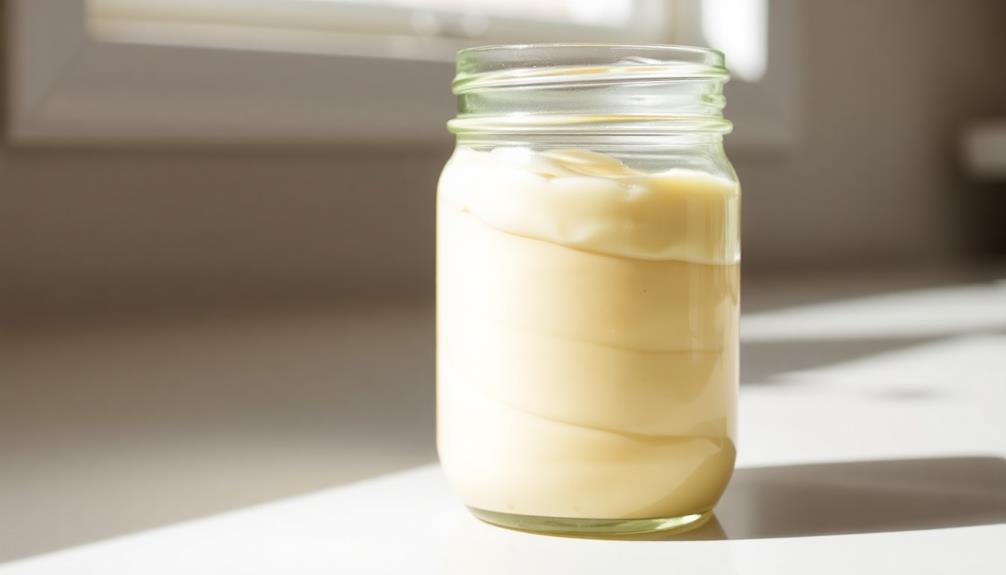
Store your freshly made mayonnaise in an airtight container and chill it in the refrigerator. This is the key to keeping your mayonnaise fresh and delicious. The cool temperature slows down the breakdown of the emulsion, preventing it from separating or spoiling.
Once your mayonnaise is stored, it'll keep in the fridge for up to 1 week. Be sure to use it within this time frame for the best flavor and texture. Mayonnaise is an oil-based condiment, so storing it at room temperature could cause it to spoil quickly.
Whenever you need to use your homemade mayo, simply take the container out of the fridge. The cool temperature will give the mayonnaise a thick, creamy consistency, perfect for spreading on sandwiches or using as a dip.
Just give it a quick stir before serving to reincorporate any separation. Storing your mayonnaise properly ensures you can enjoy its rich, tangy flavor whenever you need it.
Final Thoughts
Mastering the creation of delectable mayonnaise is an accomplishment worth celebrating.
You've learned the science behind this emulsion and honed your whisking skills. Now, the final step is to enjoy your homemade mayonnaise.
Whether you prefer it creamy or tangy, mayonnaise elevates every sandwich, salad, or dip. Slather it on your favorite bread, or use it as a base for flavorful spreads. The versatility of mayonnaise makes it a staple in many kitchens around the world. Its origins can be traced back to the early 18th century, with the exact history of mayonnaise being a subject of much debate among food historians. Some claim it was invented in France, while others argue it originated in Spain. Regardless of its precise origins, mayonnaise has become a beloved condiment that adds richness and flavor to a wide variety of dishes. Its creamy texture and tangy taste have stood the test of time, making it a timeless favorite in the culinary world.
Mayonnaise also makes a fantastic dipping sauce for crispy fries or tender chicken tenders.
Don't be afraid to experiment. Try folding in fresh herbs, spices, or a squeeze of citrus. The possibilities are endless!
Savor the satisfaction of crafting this versatile condiment from scratch. Your friends and family will be impressed by your newfound mayonnaise mastery.
Embrace your homemade mayonnaise with pride. It's a testament to your culinary skills and the joy of creating something delicious with your own two hands.
Frequently Asked Questions
How Long Does Homemade Mayonnaise Last in the Refrigerator?
Your homemade mayonnaise will typically last 3-4 days in the refrigerator. Be sure to store it in an airtight container and consume it within that timeframe for the best quality and food safety.
Can I Use a Hand Mixer Instead of a Blender?
You can absolutely use a hand mixer instead of a blender to make homemade mayonnaise. The key is to start slowly and gradually increase the speed as the emulsion forms. Just be sure to have a steady hand for best results.
What Are the Best Oil Options for Making Mayonnaise?
When making mayonnaise, you can use a variety of oils like neutral-flavored vegetable, canola, or grapeseed oil. Each oil will lend a slightly different flavor and texture to your homemade mayonnaise. Experiment to find the one that suits your taste best.
How Can I Adjust the Flavor of My Mayonnaise?
To adjust the flavor of your mayonnaise, you can experiment with adding different herbs, spices, or condiments like garlic, Dijon mustard, or lemon juice. Play around with the ratios to find your perfect flavor balance.
Is It Safe to Use Raw Eggs in Homemade Mayonnaise?
Using raw eggs in homemade mayonnaise can be risky due to the potential for salmonella. It's safer to opt for pasteurized eggs or consider an egg-free mayonnaise recipe. Take the necessary precautions to ensure your mayonnaise is safe to consume.
